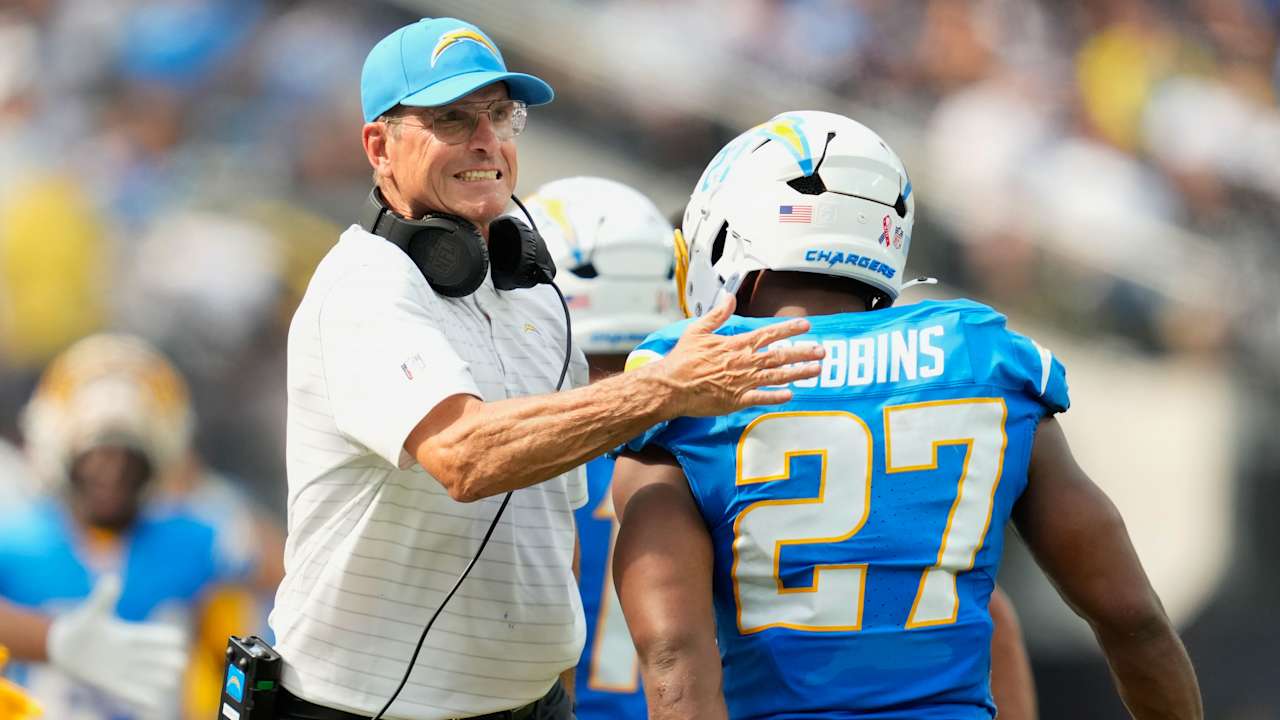Jim Harbaugh’s Chargers will thrive in today’s NFL; Marvin Harrison Jr. struggles, Klint Kubiak shines

The 60-year-old head coach leaned into a ground-and-pound approach to resurrect the University of San Diego, Stanford and the Niners before rebuilding Michigan into a true powerhouse. Consequently, it wasn’t at all surprising to see the Chargers rely on a run-heavy game plan to knock off the Raiders, 22-10, in Harbaugh’s debut with the team last Sunday. Los Angeles finished with more yards rushing (176) than passing (140). J.K. Dobbins led the way with 135 yards and a touchdown on just 10 carries, while Justin Herbert completed 17 of his 26 passes for a modest 144 yards and a score.
Though it is only a one-game sample, the Bolts’ winning formula is similar to the strategy that helped Harbaugh compile a 44-19-1 regular-season record during his first stint as a coach in the league. The former NFL quarterback believes in building his offense around the O-line and running game because winning the trenches helps every part of the team.
“The offensive line, to me, is important,” Harbaugh told reporters at the Annual League Meeting in March. “If I asked you the question of like, what position group depends on no other position group to be good, but every other position group depends on them to be good — what position group is that? Offensive line. They’re not relying on any other position group to be good, but yet every other position group relies on the offensive line to be good. And then the D-line, they’ll be the ones that argue back, ‘Yeah, we don’t need the offensive line to be good.’ … ‘Do you? Do you like when the offense has a 12-play drive and the field position?’ … ‘Yeah — oh, yeah. OK, you’re right.’ “
Harbaugh has always focused on the offensive line to spearhead his rebuilding efforts. At Stanford, he routinely put seven or eight linemen on the field in old-school, I-formation looks to bludgeon opponents into submission. The formula turned long-suffering Stanford into a legit power, with the Cardinal playing smashmouth football under his direction and knocking off high-prestige programs like USC. After working his magic in San Francisco with a stellar offensive line — allowing quarterbacks Alex Smith and Colin Kaepernick to shine while guiding the 49ers to three straight NFC Championship Game appearances and a Super Bowl — Harbaugh built the Wolverines into a juggernaut behind an offensive line that won back-to-back Joe Moore Awards (given to the best O-line in college football). The coach had some talented signal-callers during his college years — SEE: first-round picks Andrew Luck and J.J. McCarthy — but he clearly believes in a throwback approach that makes the quarterback a side dish instead of the main entree.
Given Harbaugh’s success building elite squads on the collegiate and pro levels without featuring the quarterback as the focal point of the offense, it’s only natural that he follows this exact same approach with the Chargers, despite the presence of a highly regarded QB in Herbert. Harbaugh believes the offensive line is the tip of the spear and constructs his attack around the five best blockers on the roster.
Los Angeles’ new head coach understands the impact of the offensive line on the signal-caller’s performance. With a dominant O-line that excels in run blocking and pass protection, the game becomes easier for the guy under center. When you hand the ball off to a productive running back who churns out 4-to-5 yards a pop, the defense eventually adjusts by loading the box, inherently leaving one-on-one coverage outside. In addition, the illusions created by a complementary play-action passing game lead to bigger throwing windows and wide-open receivers down the field. As the quarterback masters the slick ball-handling maneuvers that lure linebackers and safeties to the line of scrimmage, the field opens up for receivers attacking voids at intermediate depth (10-to-19 yards). And with the increased utilization of quarters coverage across the NFL, safeties are forced to attack the line of scrimmage from depth in order to fulfill their run-gap responsibilities. Thus, the deception of the play-action passing game can produce chunk plays down the field on post routes and deep overs.
Related
NFL star intends to make shock return to football after…
By JAKE FENNER Published: 14:06 GMT, 8 March 2025 | Updated: 14:06 GMT, 8 March 2025 After
New York Jets Launch Year Three of NFL Girls Flag…
The New York Jets are delighted to announce the return of its highly successful Jets NFL Girls Flag league in London ahead of International Women's Day.
MOCK DRAFT WATCH: Interior OL emerges as top pick for…
Trevor Sikkema, Pro Football Focus: James Pearce Jr., Edge, Tennessee Why: Pearce had an incredibly impressive combine showing in the speed drills,
Shedeur Sanders places blame on media, says perceived drop in…
Former Colorado quarterback Shedeur Sanders opted out of throwing passes at last week's NFL Scouting Combine. He did, however, travel to Indianapolis and condu










